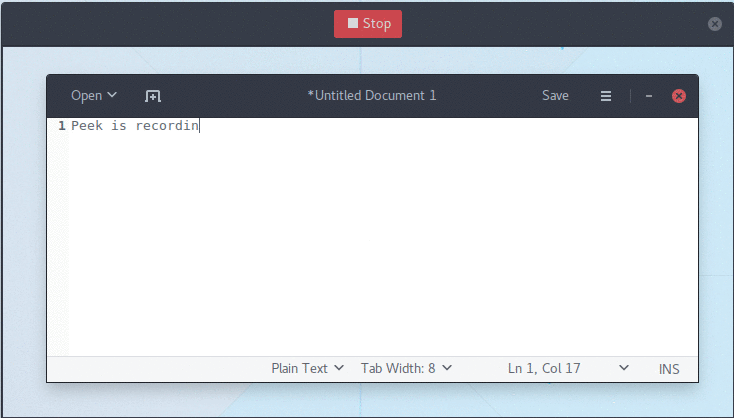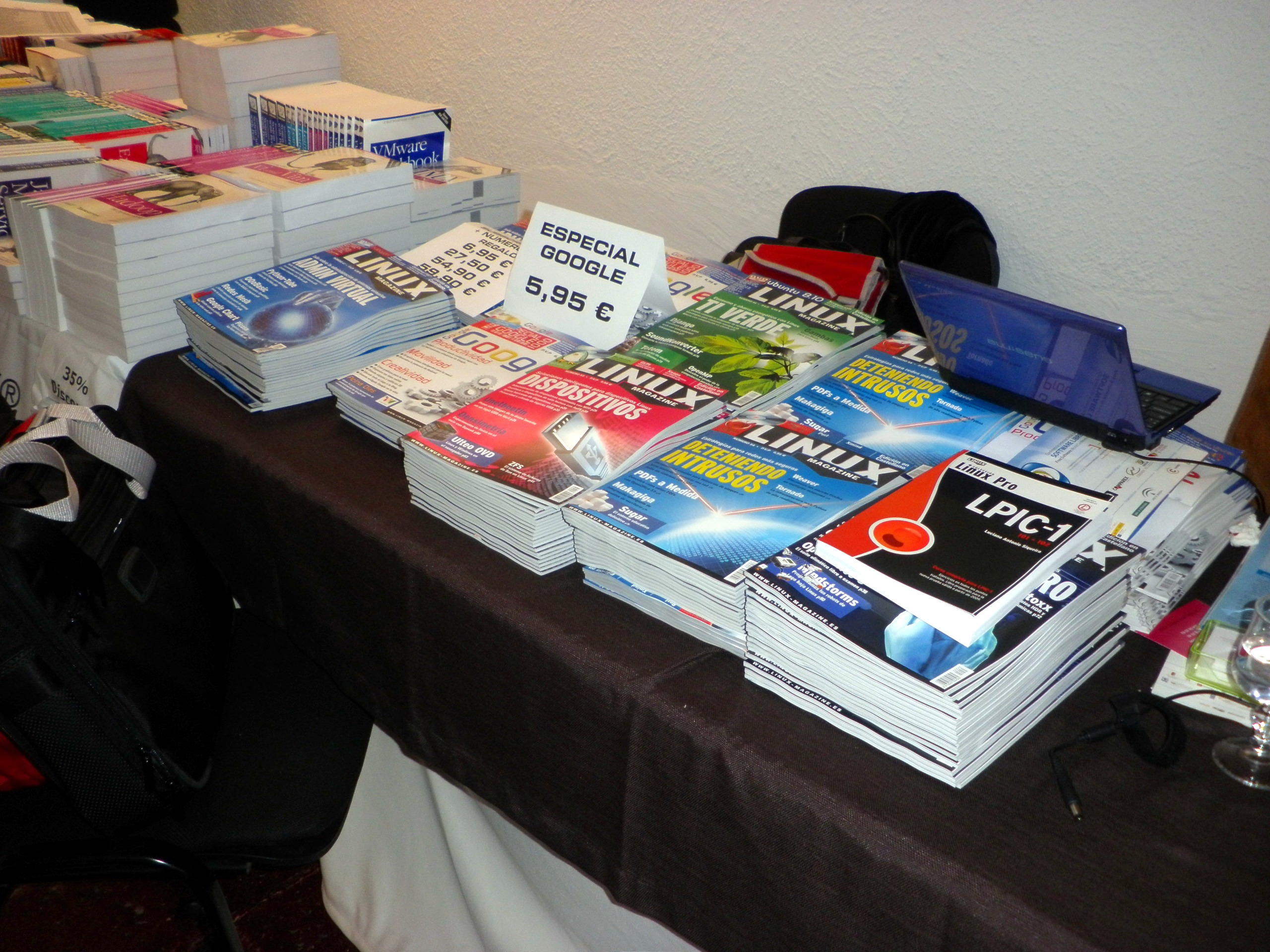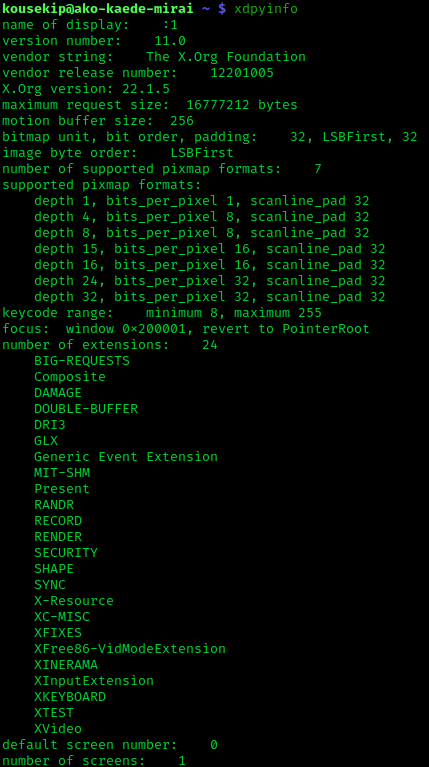|
Peek (software)
Peek is a computer software program for Linux to create simple animated GIF file based on the GIF89a file format. A screencast is created from a user-defined screen area. Peek is optimized for generating animated GIFs, but can also directly record to WebM or MPEG-4 Part 14, MP4. Peek is not a general purpose screencast app with extended features but rather focuses on the single task of creating small, silent screencasts of an area of the screen for creating GIF animations or silent WebM or MP4 videos. Peek runs on X Window System, X11 or inside a GNOME Shell Wayland (display server protocol), Wayland session using XWayland. Peek has been featured in Issue 206/2018 of the ''Linux Magazine''. On January 14, 2023peek was declared deprecated. See also * Screencast Software *Comparison of screencasting software References {{reflist External links Project website on GitHub. Free screencasting software Linux-only free software ... [...More Info...] [...Related Items...] OR: [Wikipedia] [Google] [Baidu] |
GNOME Shell
GNOME Shell is the graphical shell of the GNOME desktop environment starting with version 3, which was released on April 6, 2011. It provides basic functions like launching applications and switching between windows. GNOME Shell replaced GNOME Panel and some ancillary components of GNOME 2. GNOME Shell is written in C and JavaScript as a plugin for Mutter. In contrast to the KDE Plasma Workspaces, a software framework intended to facilitate the creation of multiple graphical shells for different devices, the GNOME Shell is intended to be used on desktop computers with large screens operated via keyboard and mouse, as well as portable computers with smaller screens operated via their keyboard, touchpad or touchscreen. History The first concepts for GNOME Shell were created during GNOME's ''User Experience Hackfest'' 2008 in Boston. After criticism of the traditional GNOME desktop and accusations of stagnation and lacking vision, the resulting discussion led to the an ... [...More Info...] [...Related Items...] OR: [Wikipedia] [Google] [Baidu] |
GitHub
GitHub () is a Proprietary software, proprietary developer platform that allows developers to create, store, manage, and share their code. It uses Git to provide distributed version control and GitHub itself provides access control, bug tracking system, bug tracking, software feature requests, task management, continuous integration, and wikis for every project. Headquartered in California, GitHub, Inc. has been a subsidiary of Microsoft since 2018. It is commonly used to host open source software development projects. GitHub reported having over 100 million developers and more than 420 million Repository (version control), repositories, including at least 28 million public repositories. It is the world's largest source code host Over five billion developer contributions were made to more than 500 million open source projects in 2024. About Founding The development of the GitHub platform began on October 19, 2005. The site was launched in April 2008 by Tom ... [...More Info...] [...Related Items...] OR: [Wikipedia] [Google] [Baidu] |
Comparison Of Screencasting Software
This page provides a comparison of notable screencasting software, used to record activities on the computer screen. This software is commonly used for desktop recording, gameplay recording and video editing. Screencasting software is typically limited to streaming and recording desktop activity alone, in contrast with a software vision mixer, which has the capacity to mix and switch the output between various input streams. Comparison by specification Comparison by features The following table compares features of screencasting software. The table has seven fields, as follows: # Product name: Product's name; sometime includes edition if a certain edition is targeted # Audio: Specifies whether the product supports recording audio commentary on the video # Entire desktop: Specifies whether product supports recording the entire desktop # OpenGL: Specifies whether the product supports recording from video games and software that employ OpenGL to render digital image # Direct3D ... [...More Info...] [...Related Items...] OR: [Wikipedia] [Google] [Baidu] |
Screencast Software
A screencast is a digital recording of computer screen output, also known as a video screen capture or a screen recording, often containing audio narration. The term ''screencast'' compares with the related term ''screenshot''; whereas screenshot generates a single picture of a computer screen, a screencast is essentially a movie of the changes over time that a user sees on a computer screen, that can be enhanced with audio narration and captions. Etymology In 2004, columnist Jon Udell invited readers of his blog to propose names for the emerging genre. Udell selected the term "screencast", which was proposed by both Joseph McDonald and Deeje Cooley. The terms "screencast," "screencam" and "screen recording" are often used interchangeably, due to the market influence of ScreenCam as a screencasting product of the early 1990s. ScreenCam, however, is a federal trademark in the United States, whereas screencast is not trademarked and has established use in publications as part of ... [...More Info...] [...Related Items...] OR: [Wikipedia] [Google] [Baidu] |
Linux Magazine
''Linux Magazine'' is an international magazine for Linux software enthusiasts and professionals. It is published by Computec Media GmbH in German-speaking countries and Linux New Media USA, LLC. for English edition. The magazine was first published in German in 1994, and later in English, Polish, Brazilian Portuguese, and Spanish. The German edition is called ''Linux-Magazin'' (); the American/Canadian edition was ''Linux Pro Magazine'' () until January of 2023 when the name changed to ''Linux Magazine''. The founding company was Articon GmbH. The magazine is published on the first Thursday of each month. Every issue includes a DVD-ROM, usually featuring a recent version of a Linux distribution. ''Linux-Magazin'' ''Linux-Magazin'' is among the oldest magazines about Linux in the world. The first German language issue appeared in October 1994, seven months after ''Linux Journals first issue, as the information paper for DELUG, the German Linux user group. The slogan of the ma ... [...More Info...] [...Related Items...] OR: [Wikipedia] [Google] [Baidu] |
XWayland
X.Org Server is the free and open-source implementation of the X Window System (X11) display server stewarded by the X.Org Foundation. Implementations of the client-side X Window System protocol exist in the form of ''X11 libraries'', which serve as helpful APIs for communicating with the X server. Two such major X libraries exist for X11. The first of these libraries was Xlib, the original C language X11 API, but another C language X library, XCB, was created later in 2001. Other smaller X libraries exist, both as interfaces for Xlib and XCB in other languages, and as smaller standalone X libraries. The services with which the X.Org Foundation supports X Server include the packaging of the releases; certification (for a fee); evaluation of improvements to the code; developing the web site, and handling the distribution of monetary donations. The releases are coded, documented, and packaged by global developers. Software architecture The X.Org Server implements the serv ... [...More Info...] [...Related Items...] OR: [Wikipedia] [Google] [Baidu] |
Wayland (display Server Protocol)
Wayland is a communication protocol that specifies the communication between a display server and its clients, as well as a C library implementation of that protocol. A display server using the Wayland protocol is called a '' Wayland compositor'', because it additionally performs the task of a compositing window manager. Wayland is developed by a group of volunteers initially led by Kristian Høgsberg as a free and open-source community-driven project with the aim of replacing the X Window System with a secure and simpler windowing system for Linux and other Unix-like operating systems. The project's source code is published under the terms of the MIT License, a permissive free software licence. As part of its efforts, the Wayland project also develops a implementation of a Wayland compositor called ''Weston''. Overview The Wayland Display Server project was started by Red Hat developer Kristian Høgsberg in 2008. Beginning around 2010, Linux desktop graphics have moved ... [...More Info...] [...Related Items...] OR: [Wikipedia] [Google] [Baidu] |
X Window System
The X Window System (X11, or simply X) is a windowing system for bitmap displays, common on Unix-like operating systems. X originated as part of Project Athena at Massachusetts Institute of Technology (MIT) in 1984. The X protocol has been at version 11 (hence "X11") since September 1987. The X.Org Foundation leads the X project, with the current reference implementation, X.Org Server, available as free and open-source software under the MIT License and similar permissive licenses. Purpose and abilities X is an architecture-independent system for remote graphical user interfaces and input device capabilities. Each person using a networked computer terminal, terminal has the ability to interact with the display with any type of user input device. In its standard distribution it is a complete, albeit simple, display and interface solution which delivers a standard widget toolkit, toolkit and protocol stack for building graphical user interfaces on most Unix-like operating syst ... [...More Info...] [...Related Items...] OR: [Wikipedia] [Google] [Baidu] |
Linux
Linux ( ) is a family of open source Unix-like operating systems based on the Linux kernel, an kernel (operating system), operating system kernel first released on September 17, 1991, by Linus Torvalds. Linux is typically package manager, packaged as a Linux distribution (distro), which includes the kernel and supporting system software and library (computing), libraries—most of which are provided by third parties—to create a complete operating system, designed as a clone of Unix and released under the copyleft GPL license. List of Linux distributions, Thousands of Linux distributions exist, many based directly or indirectly on other distributions; popular Linux distributions include Debian, Fedora Linux, Linux Mint, Arch Linux, and Ubuntu, while commercial distributions include Red Hat Enterprise Linux, SUSE Linux Enterprise, and ChromeOS. Linux distributions are frequently used in server platforms. Many Linux distributions use the word "Linux" in their name, but the Free ... [...More Info...] [...Related Items...] OR: [Wikipedia] [Google] [Baidu] |
MPEG-4 Part 14
MP4 (formally MPEG-4 Part 14), is a digital multimedia container format most commonly used to store video and audio, but it can also be used to store other data such as subtitles and still images. Like most modern container formats, it allows streaming over the Internet. The only filename extension for MPEG-4 Part 14 files as defined by the specification is .mp4. MPEG-4 Part 14 is a standard specified as a part of the MPEG-4 specifications, formally as ISO/ IEC 14496-14:2003. Unlike the audio-only compression formats MP3 and MP2, MP4 is a container format that can hold various types of media from various codecs. During the 2000s, portable media players were sometimes erroneously advertised as "MP4 players", even if they may play a different format like AMV video and not necessarily the MPEG-4 Part 14 format. Data streams Most kinds of data can be embedded in MPEG-4 Part 14 files through ''private streams''. A separate hint track is used to include streaming information in ... [...More Info...] [...Related Items...] OR: [Wikipedia] [Google] [Baidu] |
WebM
WebM is an audiovisual media file format. It is primarily intended to offer a royalty-free alternative to use in the HTML video and the HTML audio elements. It has a sister project, WebP, for images. The development of the format is sponsored by Google, and the corresponding software is distributed under a BSD licenses, BSD license. The WebM Digital container format, container is based on a Profile (engineering), profile of Matroska. WebM initially supported VP8 video and Vorbis audio streams. In 2013, it was updated to accommodate VP9 video and Opus (audio format), Opus audio. It also supports the AV1 codec. Vendor support Software Native WebM support by Firefox, Mozilla Firefox, Opera (web browser), Opera, and Google Chrome was announced at the 2010 Google I/O conference. Internet Explorer 9 requires third-party WebM software. In 2021, Apple Inc., Apple released Safari (web browser), Safari 14.1 for macOS, which added native WebM support to the browser. , QuickTime does n ... [...More Info...] [...Related Items...] OR: [Wikipedia] [Google] [Baidu] |





